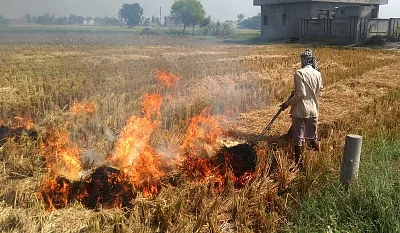As the sun cuts through the October skies, my nose is runny. Sneezes and allergy return. But I am not alone, thousands of Delhiites share my suffering and the most vulnerable groups — Old, children, pregnant and people suffering from respiratory diseases, panic at the sight of winter.
News reports confirm that Delhi, relatively less polluted this Diwali (325 vs 462 AQI), but the worst is yet to come. After all, this was early Diwali and winter temperatures are a few weeks out.
Air Pollution and Stubble Burning Have Strong Links
Delhi’s top pollution sources are vehicular emissions, industrial effluents and construction dust and finally, stubble burning which is episodic but adds to smog each winter.
The low temperatures ensure that the particulate matter remain suspended in our breathing ranges. But not to jinx the clean air and sunshine, the soot is coming.
The fires in paddy-growing northern area are only about to begin.
India Needs Better Straw Management Strategies
The untimely rains wet the crops, and many farmers are waiting for the crops to dry out before the burning begins. Ground reports confirm that winter sowing is delayed, and hence, most farmers especially in the Punjab area will have a very short window to harvest paddy and sow wheat.
So how does that relate to the problems of Delhi’s air pollution? Time-pressed farmers are not going to wait for the happy seeder or think of mulching the ground, they will have little choice but to clear the fields and burn the residues, thus, sending soot down our airways.
So what happened to the thousands of crores spent on cleaning Delhi’s air and to stop stubble burning? The government did roll out subsidies for purchase of mulching machines, straw harvesters like Happy and Super Seeder and wanted to enroll farmers and Farmer Producer Organisations(FPOs) to spread awareness about stubble burning but this scheme has failed miserably.
The reasons are quite simple—poor implementation strategy. And that’s why there are only a few straw management machines in the country side.
More Mulching Mechanism Needed
The lucky villages got at best, one for two machines to mulch hundreds and thousands of acres.
Keep in mind that the Happy Seeder can only mulch and seed between 10-15 acres a day and the transitory period between paddy to wheat sowing is a week to ten days.
It would take weeks if not months to mulch and seed an average Punjabi village with just one machine. With little time to harvest and sow, the Happy Seeder becomes an impractical option for the farmers.
Happy Seeders Overwhelm Farmers With Power Overdraw
The second reason why Happy seeders have not seen wide scale adoption is —power requirements.
The Happy Seeder needs high-power tractor, while the Super Seeder draws a lot more power. This requirement is incompatible with the low- powered tractors in the farmers’ possession.
To adopt the Happy Seeder, the farmers need to buy a new tractor and then make additional investments to replace all other farm machines like rotavators, to ensure they are compatible with the high-power tractor. So, by introducing Happy seeder to garages, the farmers have to overhaul the farm machinery.
Maybe, this is the reason why the government has failed to mobilise farmers through FPOs and farmers' unions in the affected areas. The economic burden and benefits are not commensurate.
High Prices & Corruption Mar Anti-Stubble Solutions
Now, given the high rate of fuel and fertilisers, majority of farmers couldn’t afford to get their stubble removed. It comes down to additional Rs 2500-3000/per acre if the farmers want to clear their stubble using the combined harvester. Manual stubble clearing is a lot more expensive.
The government has failed to create an economic safety net for farmers and support the anti-stubble drive. No financial or Direct Benefit Transfer (DBT) incentives were given for ecosystem services that the farmers can provide in Delhi and North India. Our policy has failed to change farmers' behaviour.
Farmers in the Punjab area also complained of corruption and the preference given to certain agencies.
Many farmers were asked for commissions, and often found themselves unable to reach the government-registered agencies to buy the straw management equipments.
There has also been a sharp price rise in the government’s preferred Happy seeder models. In the open market, these models sell at much higher rates. Overall, farmers feel that this collusion between the manufactures, agencies and government is failing to help farmers.
Economical, Accessible Technology Will Aid Farmers
The other issue is of tech redundancy. The government's straw management solutions and equipment are first of all, expensive and for all the reasons mentioned above, quite redundant as well.
The farmers want cheaper, more accessible and farmer- friendly, low cost tech to help with stubble instead of expensive industrial solutions. But there is no financial support to innovate or use alternative machines.
Finally, the government has aggressively promoted briquetting or creation of straw bricks or pellets from stubble, but on the ground level, a lot more is needed. Even if the farmers create stubble bales somehow, where are they going to sell it?
There isn’t enough industry or support infrastructure to absorb the billions of bales coming out of Punjab in Kharif. With no support or choice the farmers are burning the stubble and we each year get the cough!
(Indra is an independent agriculture analyst and writer. He was also the former director, policy and outreach, National Seed Association of India.)
(This is an opinion piece and the views expressed above are the author’s own. The Quint neither endorses nor is responsible for the same.)
